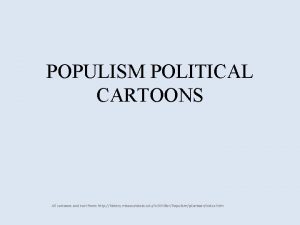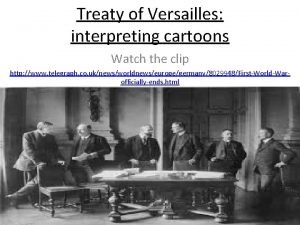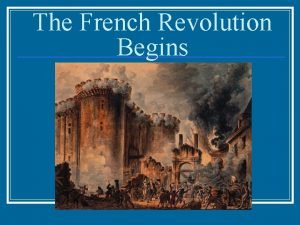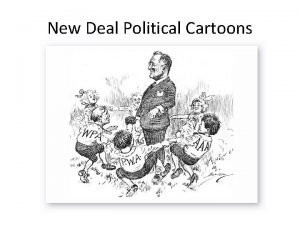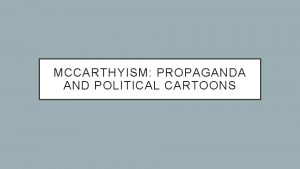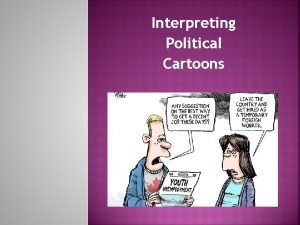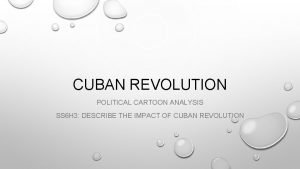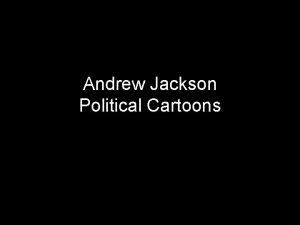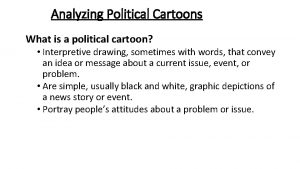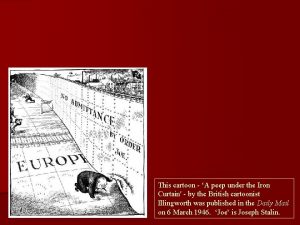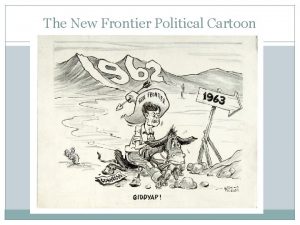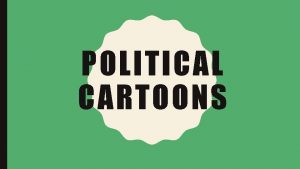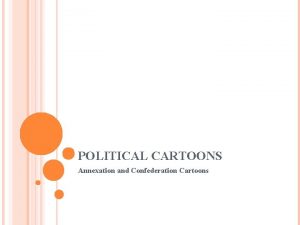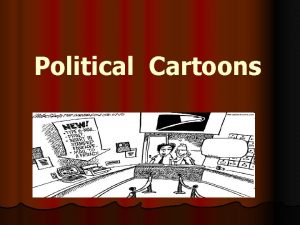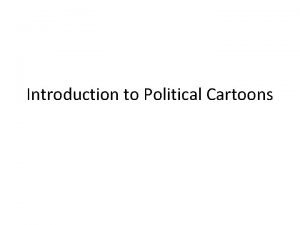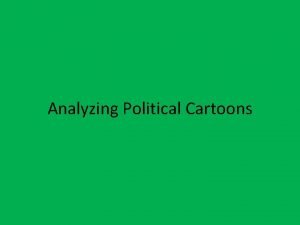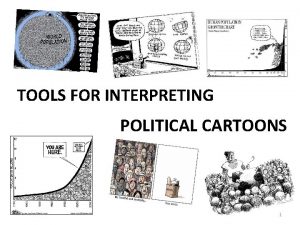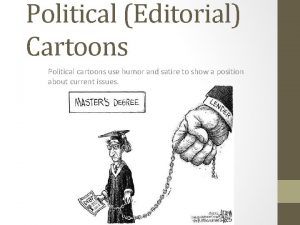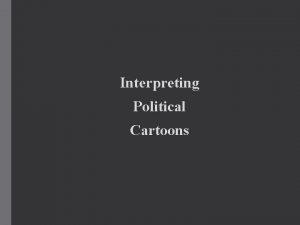The Cold War through Political Cartoons Visit Mrs















- Slides: 15

The Cold War through Political Cartoons Visit Mrs. Gregovich Mutually Assured Destruction The Iron Curtain Cuba Artifact 1 Museum Entrance Welcome to the Lobby

Name of Museum Mrs. Gregovich Add Picture Here I have put this Cold War museum together with Political Cartoons, which are actually (guess what? ) primary sources. To read the information about a picture, just click the blue border around the picture and it will give you lots of information! Back to Lobby Note: Virtual museums were first introduced by educators at Keith Valley Middle School in Horsham, Pennsylvania. This template was designed by Lindsey Warneka under the direction of Dr. Christy Keeler during a Teaching American History grant module. View the Educational Virtual Museums website for more information on this instructional technique.

Name of Museum Mutually Assured Destruction Artifact 2 Back to Lob by Artifact 3 Artifact 4

Name of Museum Iron Curtain Artifact 5 Back to Lob by Artifact 6 Artifact 7

Name of Museum Communist Cuba Artifact 8 Back to Lob by Artifact 9 Artifact 10

Name of Museum Bert the Turtle Insert Artifact Picture Here Bert the Turtle was a cartoon that taught children what to do in case there was…you know… a nuclear attack. The Duck and Cover film was released in 1951 by the federal government’s civil defense branch after the Soviet Union began testing nuclear bombs. Bert the Turtle was shown in schools beginning in 1952 as part of the “Duck and Cover” awareness campaign…awareness about the constant threat of nuclear attack…anytime… anywhere. Back to Room 1

Name of Museum “Let’s Get a Lock for This Thing!” Insert Artifact Picture Here http: //apus-06 -07. wikispaces. com/sixties+political+cartoons This cartoon was drawn by cartoonist Herbert Lawrence Block, commonly known as Herblock, most popular for his cartoons concerning national domestic and foreign policy from a liberal perspective. The cartoon shows US president John F. Kennedy with Russian leader Nikita Khrushchev on top of Pandora’s Box labeled ‘nuclear war’ both looking at the other in a worn out and confused manner, possible representing a stalemate or confused state. Pandora’s Box is representative of the Cold War, showing that neither country had a strong desire to participate in nuclear action but was on the same page as the other and did not know where the Cold War was headed and was forced to stay prepared for the worst case scenario. Back to Room 1

Name of Museum The Butter Battle Book Insert Artifact Picture Here en. wikipedia. org/wiki/The_Butter_Battle_Book Published January 12, 1984, this Dr. Seuss story is considered an anti-war story that looked at ideas such as the arms race, mutually assured destruction and nuclear war. Dr. Seuss is known for his children’s books, but he actually had many political cartoons during World War II and the Cold War. This book is one of those artifacts that shows Dr. Seuss’s political side and how even children’s books can be a commentary on society. Back to Room 1

Name of Museum Dr. Strangelove Insert Artifact Picture Here http: //www. imdb. com/title/tt 0057012/ Or: How I learned to Stop Worrying and Love the Bomb Released in 1962, this film makes a mockery of “Fail. Safe”, a movie about the possibility of computer technology backfiring and detonating an atomic bomb in Moscow. In Dr. Strangelove, almost every fear or common belief about the Cold War and the threat of Nuclear War is made into a satirical joke. Back to Room 1

Name of Museum You Try it Sister! Insert Artifact Picture Here http: //multimedialearningllc. wordpress. com /tag/teaching-the-cold-war/ The Cold War is rich with symbols that help students truly understand the conflict. This cartoon is no exception. Published in 1947 in the wake of Soviet involvement in Greece and Turkey, Jay “Ding” Darling captures the feelings of the hopelessness ahead in resolving issues with communist Russia. Back to Room 2

Name of Museum Soviet Takeover Insert Artifact Picture Here www. johndclare. net/cold_war 6. htm This cartoon by the British cartoonist Illingworth was published in June 1947. Stalin is depicted as reaching out beyond the Iron Curtain, trying to plant the Soviet flag in western Europe- the cartoonist has drawn a question mark in France, suggesting that France may be the next country that Stalin tries to take over. Back to Room 2

Name of Museum No Admittance Insert Artifact Picture Here www. iancfriedman. com/? p=380 “From Stettin in the Baltic to Trieste in the Adriatic an iron curtain has descended across the Continent. Behind that line lie all the capitals of the ancient states of Central and Eastern Europe. Warsaw, Berlin, Prague, Vienna, Budapest, Belgrade, Bucharest and Sofia; all these famous cities and the populations around them lie in what I must call the Soviet sphere, and all are subject, in one form or another, not only to Soviet influence but to a very high and in some cases increasing measure of control from Moscow…” Winston Churchill Back to Room 2

Name of Museum This Hurts Me More Than You Insert Artifact Picture Here http: //multimedialearningllc. wordpress. com/tag/te aching-the-cold-war/ This cartoon, drawn by Edmund Valtman and published in The Hartford Times, October 30, 1962. Notice how Castro’s teeth are little missiles? And Khrushchev is the guy to pull them out? How does this relate to the Cuban Missile Crisis? Back to Room 3

Kennedy vs. Khrushchev Name of Museum Insert Artifact Picture Here http: //multimedialearningllc. wordpress. com/tag/cold-warpropaganda/ The Cold War was a terrifying time because of the high stakes involved with new weapons and mutually assured destruction. Tensions peaked in the early 1960 s when JFK and Khrushchev took us to the brink of nuclear war, which would have killed billions and ended human civilization as we know it. Back to Room 3

Name of Museum Communist Castro Insert Artifact Picture Here http: //vikingkitties. blogspot. com/ This is one of the more contemporary of the cartoons in this museum. What is the message? Who’s biased is represented here? Do you believe that Russia and Cuba are still closely tied together, and why? Back to Room 3
 Lesson 1 the cold war begins
Lesson 1 the cold war begins Populism political cartoon
Populism political cartoon Analyzing the populist party through political cartoons
Analyzing the populist party through political cartoons Proxy war cold war definition
Proxy war cold war definition At the peace table political cartoon
At the peace table political cartoon Marie antoinette political cartoon
Marie antoinette political cartoon Stock market crash 1929 political cartoon
Stock market crash 1929 political cartoon Bolshevik revolution political cartoon
Bolshevik revolution political cartoon How the south interprets the new deal
How the south interprets the new deal Mccarthyism political cartoon
Mccarthyism political cartoon Interpreting political cartoons
Interpreting political cartoons Cuban missile crisis political cartoon
Cuban missile crisis political cartoon Andrew jackson political cartoons
Andrew jackson political cartoons Political cartoons
Political cartoons Cartoon by leslie gilbert illingworth, 6 march 1946
Cartoon by leslie gilbert illingworth, 6 march 1946 Jfk assassination political cartoon
Jfk assassination political cartoon

